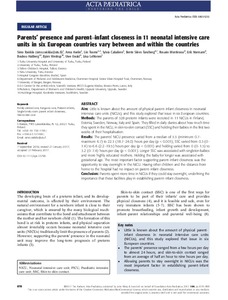Parents ' presence and parent-infant closeness in 11 neonatal intensive care units in six European countries vary between and within the countries
Raiskila S; Axelin A; Toome L; Caballero S; Tandberg BS; Montirosso R; Normann E; Hallberg B; Westrup B; Ewald U; Lehtonen L
Parents ' presence and parent-infant closeness in 11 neonatal intensive care units in six European countries vary between and within the countries
Raiskila S
Axelin A
Toome L
Caballero S
Tandberg BS
Montirosso R
Normann E
Hallberg B
Westrup B
Ewald U
Lehtonen L
WILEY
Julkaisun pysyvä osoite on:
https://urn.fi/URN:NBN:fi-fe2021042717453
https://urn.fi/URN:NBN:fi-fe2021042717453
Tiivistelmä
Aim: Little is known about the amount of physical parent-infant closeness in neonatal intensive care units (NICUs), and this study explored that issue in six European countries.Methods: The parents of 328 preterm infants were recruited in 11 NICUs in Finland, Estonia, Sweden, Norway, Italy and Spain. They filled in daily diaries about how much time they spent in the NICU, in skin-to-skin contact (SSC) and holding their babies in the first two weeks of their hospitalisation.Results: The parents' NICU presence varied from a median of 3.3 (minimum 0.7-maximum 6.7) to 22.3 (18.7-24.0) hours per day (p < 0.001), SSC varied from 0.3 (0-1.4) to 6.6 (2.2-19.5) hours per day (p < 0.001) and holding varied from 0 (0-1.5) to 3.2 (0-7.4) hours per day (p < 0.001). Longer SSC was associated with singleton babies and more highly educated mothers. Holding the baby for longer was associated with gestational age. The most important factor supporting parent-infant closeness was the opportunity to stay overnight in the NICU. Having other children and the distance from home to the hospital had no impact on parent-infant closeness.Conclusion: Parents spent more time in NICUs if they could stay overnight, underlining the importance that these facilities play in establishing parent-infant closeness.
Kokoelmat
- Rinnakkaistallenteet [27094]
